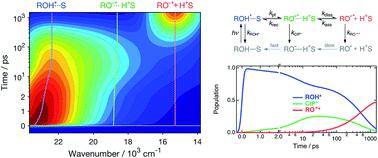当前位置:
X-MOL 学术
›
Chem. Sci.
›
论文详情
Our official English website, www.x-mol.net, welcomes your
feedback! (Note: you will need to create a separate account there.)
Broadband fluorescence reveals mechanistic differences in excited-state proton transfer to protic and aprotic solvents
Chemical Science ( IF 7.6 ) Pub Date : 2020-07-08 , DOI: 10.1039/d0sc03316b Pragya Verma 1, 2, 3, 4 , Arnulf Rosspeintner 1, 2, 3, 4 , Bogdan Dereka 1, 2, 3, 4 , Eric Vauthey 1, 2, 3, 4 , Tatu Kumpulainen 1, 2, 3, 4
Chemical Science ( IF 7.6 ) Pub Date : 2020-07-08 , DOI: 10.1039/d0sc03316b Pragya Verma 1, 2, 3, 4 , Arnulf Rosspeintner 1, 2, 3, 4 , Bogdan Dereka 1, 2, 3, 4 , Eric Vauthey 1, 2, 3, 4 , Tatu Kumpulainen 1, 2, 3, 4
Affiliation

|
Excited-state proton transfer (ESPT) to solvent is often explained according to the two-step Eigen–Weller model including a contact ion pair (CIP*) as an intermediate, but general applicability of the model has not been thoroughly examined. Furthermore, examples of the spectral identification of CIP* are scarce. Here, we report on a detailed investigation of ESPT to protic (H2O, D2O, MeOH and EtOH) and aprotic (DMSO) solvents utilizing a broadband fluorescence technique with sub-200 fs time resolution. The time-resolved spectra are decomposed into contributions from the protonated and deprotonated species and a clear signature of CIP* is identified in DMSO and MeOH. Interestingly, the CIP* intermediate is not observable in aqueous environment although the dynamics in all solvents are multi-exponential. Global analysis based on the Eigen–Weller model is satisfactory in all solvents, but the marked mechanistic differences between aqueous and organic solvents cast doubt on the physical validity of the rate constants obtained.
中文翻译:

宽带荧光揭示了激发态质子转移到质子和非质子溶剂中的机理差异
经常根据两步Eigen–Weller模型(包括作为中间产物的接触离子对(CIP *))解释激发态质子转移(ESPT)到溶剂的过程,但是该模型的一般适用性尚未得到全面检验。此外,缺乏CIP *光谱识别的示例。在这里,我们报告了对质子(H 2 O,D 2O,MeOH和EtOH)和非质子(DMSO)溶剂,采用宽带荧光技术,时间分辨率低于200 fs。时间分辨光谱被分解为质子化和去质子化物质的贡献,并在DMSO和MeOH中鉴定出CIP *的清晰特征。有趣的是,尽管在所有溶剂中的动力学都是指数级的,但在水性环境中却无法观察到CIP *中间体。基于Eigen-Weller模型的全局分析在所有溶剂中均令人满意,但是水性和有机溶剂之间明显的机械差异使人们对所获得的速率常数的物理有效性产生怀疑。
更新日期:2020-08-05
中文翻译:

宽带荧光揭示了激发态质子转移到质子和非质子溶剂中的机理差异
经常根据两步Eigen–Weller模型(包括作为中间产物的接触离子对(CIP *))解释激发态质子转移(ESPT)到溶剂的过程,但是该模型的一般适用性尚未得到全面检验。此外,缺乏CIP *光谱识别的示例。在这里,我们报告了对质子(H 2 O,D 2O,MeOH和EtOH)和非质子(DMSO)溶剂,采用宽带荧光技术,时间分辨率低于200 fs。时间分辨光谱被分解为质子化和去质子化物质的贡献,并在DMSO和MeOH中鉴定出CIP *的清晰特征。有趣的是,尽管在所有溶剂中的动力学都是指数级的,但在水性环境中却无法观察到CIP *中间体。基于Eigen-Weller模型的全局分析在所有溶剂中均令人满意,但是水性和有机溶剂之间明显的机械差异使人们对所获得的速率常数的物理有效性产生怀疑。











































 京公网安备 11010802027423号
京公网安备 11010802027423号